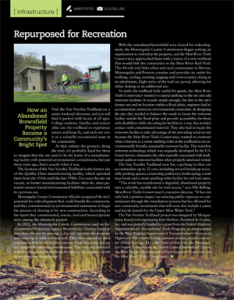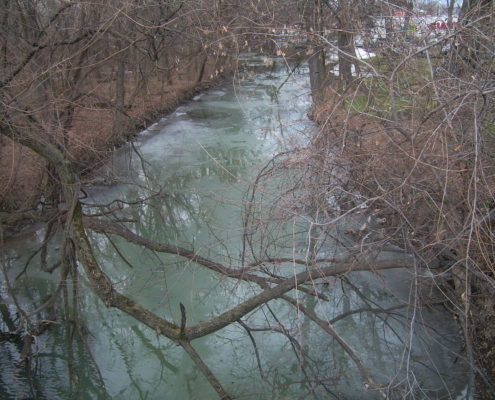 HRG’s Morgantown Office Manager Samer Petro wrote an article about our Van Voorhis Trailhead project for the Summer 2016 issue of West Virginia Executive magazine. The article is shared here with their permission and is also available in the online edition of their magazine.
HRG’s Morgantown Office Manager Samer Petro wrote an article about our Van Voorhis Trailhead project for the Summer 2016 issue of West Virginia Executive magazine. The article is shared here with their permission and is also available in the online edition of their magazine.
Visit the Van Voorhis Trailhead on a sunny weekend afternoon, and you will find it packed with locals of all ages. College students, families and seniors alike use the trailhead to experience nature and keep fit, and each one sees it as a valuable recreational asset in the community.
As they admire the greenery along the trail, it’s probably hard for them to imagine that the site used to be the home of a manufacturing facility with potential environmental contaminants, but just three years ago, that’s exactly what it was.
The location of the Van Voorhis Trailhead is the former site of the Quality Glass manufacturing facility, which operated there from the 1930s until the late 1980s. For years the site sat vacant, as former manufacturing facilities often do, since potential owners feared environmental liabilities associated with its previous use.
Monongalia County Commission officials recognized the site’s potential for redevelopment that could benefit the community, and they commissioned an environmental assessment to begin the process of clearing it for new construction. According to the report they commissioned, arsenic, lead and benzo(a)pyrene were among the chemicals present.
In 2012, the Monongalia County Commission used an Environmental Protection Agency Brownfields Cleanup Grant to remediate the site by placing a clay soil cap over the property and covering it with new top soil. They then agreed to deed restrictions that would prevent anyone from breaching the cap and potentially releasing contaminants. The deed also restricted withdrawing groundwater from the site for any purpose except monitoring and remediation.
With the remediated brownfield area cleared for redevelopment, the Monongalia County Commission began seeking an organization to redevelop the property, and the Mon River Trails Conservancy approached them with a vision of a new trailhead that would link the community to the Mon River Rail-Trail. This 48-mile trail links urban and rural communities in Marion, Monongalia and Preston counties and provides an outlet for walking, cycling, running, jogging and cross-country skiing to its inhabitants. Eight miles of the trail are paved, allowing for inline skating as an additional use.
To make the trailhead truly useful for guests, the Mon River Trails Conservancy wanted to expand parking on the site and add restroom facilities. It sounds simple enough, but due to the site’s former use and its location within a flood plain, engineers had to accommodate numerous environmental constraints. In designing the site, they needed to balance the needs to locate the restroom facility outside the flood plain and provide accessibility for those with disabilities while also siting the facilities in a way that avoided contact with contaminated material. They also had to locate the restroom facility to take advantage of the prevailing wind on site because the Mon River Trails Conservancy wanted to construct what is known as a sweet smelling toilet at the trailhead as an environmentally friendly, sustainable restroom facility. This waterless restroom technology, which was originally developed by the U.S. Forest Service, eliminates the odor typically associated with traditional outdoor restroom facilities when properly sited and vented.
The Van Voorhis Trailhead now has a parking lot that can accommodate up to 32 cars, including several handicap-accessible parking spaces; connecting pathways; landscaping; a trail map kiosk and a sweet smelling toilet facility for rail-trail users.
“This work has transformed a degraded, abandoned property into a valuable, useable site for trail access,” says Ella Belling, Mon River Trails Conservancy’s executive director. “It has not only had a positive impact on reducing public exposure to contaminants through the remediation process but has allowed for new community investments that will soon also include a canoe and kayak launch for the Upper Mon Water Trail.”
The Van Voorhis Trailhead project was designed by Morgantown-based civil engineering firm Herbert, Rowland & Grubic, Inc. and was partially funded by a grant from the Federal Highway Administration’s Recreational Trails Program, as administered by the West Virginia Department of Transportation’s Division of Highways. Other contributing partners include project contractor AllStar Ecology, LLC; the Town of Star City; the Monongalia County Commission; the North Central Brownfield Center; the West Virginia Department of Environmental Protection and the Mon River Trails Conservancy.
 HRG is partnering with LandStudies, Inc., to prepare a TMDL plan for Paxton Creek beginning in the spring of 2017.
HRG is partnering with LandStudies, Inc., to prepare a TMDL plan for Paxton Creek beginning in the spring of 2017.
